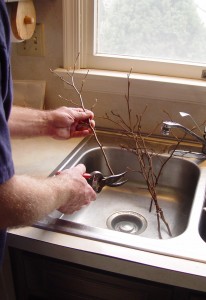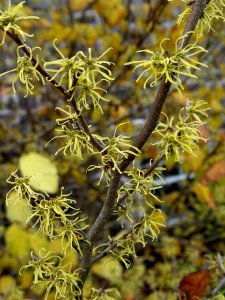Forcing Branches
January 7th, 2012
Here’s a way to brighten your house in winter while impressing everyone with your gardening expertise – even though you actually do little and know even less.
Sound like something up your alley? Then give “forcing branches” a try.
OK, the term sounds deviant. But forcing branches really is nothing more than cutting live branches from trees and shrubs and causing them to bloom by putting them in water inside.
It’s one of those things that seems tricky but is actually incredibly easy – and cheap. Certainly easier than forcing bulbs. It’s a wonder more people don’t try it.
Plants that work best are those that naturally flower before May – things like fruit trees, lilacs, azaleas, rhododendrons, redbuds, witch hazels, forsythias and magnolias. These are species that produce their flower buds the year before.
Later bloomers such as butterfly bushes, hydrangeas, roses and summersweet can’t be forced because they will produce flowers on this year’s new wood.
Under normal circumstances, warming spring temperatures and lengthening days trigger flower buds to swell and open. Forcing fakes plants into speeding up the process.
The usual technique is simply to cut branches (or branch tips) and then plunge their cut ends in a bucket of very warm water. Temperatures of around 100 to 110 degrees are perfect – about as warm as you can stand putting your hands in. The branches should stay in that bucket for at least six hours.
Branches of a half-inch in diameter and less are ideal, and cuttings are best collected when outdoor temperatures are above freezing. Look for branches with plump buds. They’re usually the flower buds. Leaf buds are normally thinner.
The hot water helps move that first burst of moisture up into the stems. Also helpful is making a fresh angled cut an inch or two above the original cut before putting the branches in the water-filled vases in which they’re to be displayed.
Maximize display life by adding a little floral preservative, antibacterial mouthwash or lemon-lime soda to the water to prevent bacteria growth. One recipe calls for one tablespoon of mouthwash per quart of water.
Another option is to let the cut branches in the original bucket of water until they bloom. Then they can be moved into vases as needed.
Make a fresh cut whenever the cut ends are exposed to air. That exposure will lead to healing, and when the cut end seals, it can’t take up new water.
Most branches take two to four weeks inside before they bloom, although a few go as long as six weeks. Once in bloom, the flowers last about a week.
Add new preservative and top off the water each week. If the water discolors or begins to smell, replace it.
The earliest trees and shrubs to bloom are also the best ones to cut for earliest forcing. In general, the longer the time that branches are cut before their natural bloom, the longer it takes them to bloom inside.
Example: Forsythia branches cut around Christmas might not bloom for three to four weeks while ones cut in early March may open in a few days.
There’s a limit to how early you can cut branches, too. That’s because different species have different “chilling” requirements before buds are in position to open.
Chill time occurs at 40 degrees and less. Most of our spring bloomers will be ready to flower after about six weeks of chilling, but some of the late-spring bloomers need eight or 10 weeks.
The chart below lists earliest cutting times for some of the best forcing species. But don’t be afraid to experiment and see what happens.
If something doesn’t open, take new cuttings later. Odds are the second round will flower.
Even if you don’t get flowers, you’ll probably at least get leaves. Those can be ornamental in their own right. Japanese maple are particularly nice – especially the red, cut-leaf types.
Forced branches look simple but elegant in a vase by themselves. Or they can be paired with cut forced bulbs or cut flowers from the florist. Or try mixing several types of branches for a mixed branch bouquet.
Even if all fails and you get nothing, look at it this way… at least you got a jump on your spring pruning.
* Trees and shrubs to cut for forcing from January on: Cornelian cherry dogwood, filbert, forsythia, fothergilla, witch hazel.
* Trees and shrubs to cut for forcing from early February on: apple, cherry, crabapple, ornamental pear.
* Trees and shrubs to cut for forcing from mid-February on: beech, birch, Japanese maple, lilac, magnolia, PJM rhododendron, quince, red maple, serviceberry, willow.









